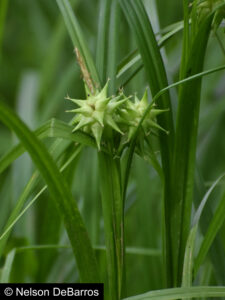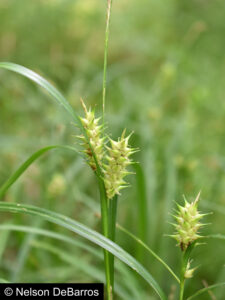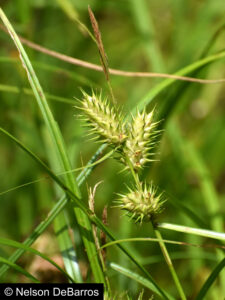Section Lupulinae
Gray's Sedge (Carex grayi)
Habitat: Floodplain forests and swamps; In Fairfax County, this species is typically found along larger waterways such as the Potomac River and Bull Run.
Characteristics: The pistillate spike is shaped like a Medieval mace, with the perigynia beaks pointing in every direction, including downward. As the perigynia mature, they usually become somewhat compressed unlike those of C. intumescens.
Global Rank/State Rank: G4G5/S4
False Hop Sedge (Carex lupuliformis)
Habitat: In Fairfax County, this uncommon species has been found in floodplain swamps and upland depression swamps in the Triassic Basin.
Characteristics: This species is remarkably similar to C. lupulina. The most reliable distinguishing characteristic is the shape of the mature achenes which are about as long as wide and have noticeably thickened “nodes” or “nubbins” along their edges (see photos in gallery). These nodes are prominent enough to be felt while rolling a perigynium between your fingers. Vegetative features that can be helpful to differentiate C. lupuliformis from C. lupulina include: (1) the peduncles of the staminate spikes far exceed the top of the uppermost pistillate spikes (vs. staminate peduncles shorter than or just about equaling the uppermost pistillate spike on C. lupulina) and (2) loosely spaced, rhizomatous culms (as opposed to dense, cespitose clumps on C. lupulina). Note, however, that C. lupulina is a variable species and can produce individual culms or genets that approximate the vegetative characteristics discussed here.
Global Rank/State Rank: G4/S1S2
Hop Sedge (Carex lupulina)
Habitat: Wide range of wetland types including floodplain swamps, depression swamps, and tidal swamps.
Characteristics: A widespread and variable species. Produces large pistillate spikes with perigynia that are widely spreading to ascending. Generally forms dense, cespitose clumps, but occasionally has a looser structure.
Global Rank/State Rank: G5/S5









